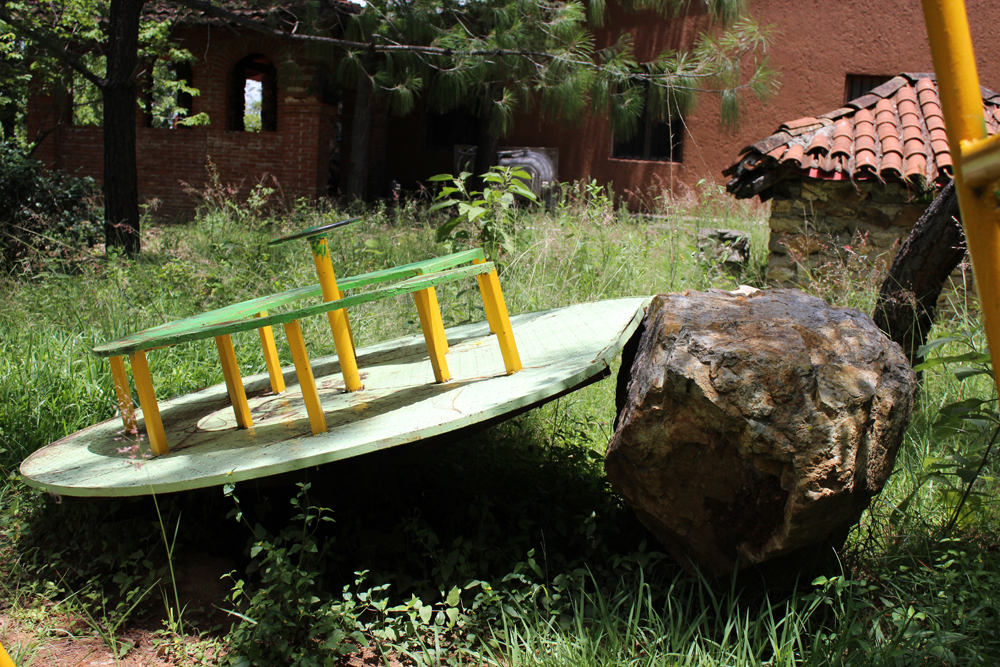Postcard from Oaxaca
Leslie Moody Castro explores the burgeoning gallery scene in the south of Mexico
Leslie Moody Castro explores the burgeoning gallery scene in the south of Mexico

In Oaxaca it sometimes seems like everyone is an artist. Highly skilled textile weavers and indigenous artisans have been working there for centuries, passing their skills down over generations. Hand-carved wooden Alebrijes and tapetes carefully woven from dried palm leaves are sold on nearly every corner of the city. Thus, it comes as no surprise that Oaxacan craft traditions have lately informed the practices of several contemporary Mexican artists. ‘Cromática’, Tania Candiani’s recent exhibition at the Museo de Arte Contemporáneo de Oaxaca (MACO), featured a number of textile and ceramic works produced using local methods. The organization Taller Lu'um connects contemporary artists and designers with Oaxacan artisans to help them learn local techniques and share profits from the sale of works produced. Casa Wabi, a residency program on the Oaxacan coast near Puerto Escondido, requires its artists in residence to work closely with the local community. This renewed interest in Oaxacan craft seems to parallel the broadening international interest in Mexican art, which has directed the attention of many Mexican artists towards the local history of their own home states.

On the morning that I arrived in Oaxaca, artists Santiago Rojo Guadarrama and Ruben Ojeda Guzmán drove me 30 minutes north of town to El Chilar, a ranch where both artists run a project space by the same name. El Chilar has a complicated history. The San Felipe del Agua ecological reserve, in which it lies, was the source of controversy when the construction of a federal highway, favoured by real estate developers, threatened the local ecology. The project was never completed, and now ends abruptly at a traffic gate. Around this time, the ranch served as a vacation rental for Sergio Castro, a party-loving accountant who allegedly embezzled billions of pesos from the government in 2014 and is currently a fugitive in Central America. It sat empty and mouldering until last year, when Guardarrama and Guzmán converted both ranch houses and the surrounding grounds into a large project space that hosts two exhibitions annually. For ‘$1800 x m2’, which was installed in both houses during my visit, site specific works by Julio Villavicencio, Adriana de la Rosa, Rubén Ojeda, Santiago Rojo, Daniel Escamilla, Santiago Pérez, Victor Morales, and Turista Mundial Colectivo pointedly addressed local political and economic issues. Villavicencio installed brightly coloured flags on the property’s main walkway, referencing the local tradition of using them to mark the path to a party. The flags led directly to a separate cluster of flags inside a gallery space – a party of its own making. According to Guadarrama and Guzmán, El Chilar’s next show will reimagine Castro’s debauched fiestas.

One of Oaxaca’s most prolific local artists is Francisco Toledo, a founder of both MACO and the Instituto de Artes Gráficas de Oaxaca (Institute for Graphic Arts), two young yet vital institutions that support a burgeoning local art scene. When I visited MACO, a more traditional contemporary art museum founded in 1992, a show of recent acquisitions by emerging national and international talent, such as Debora Delmar and Edgar Abaroa, was complimented by a solo exhibition of Spanish artist Eugenio Ampudia. Instituto de Artes Gráficas, or IAGO, is not a museum but a school for artists that also houses an expansive library and a collection of Mexican art in an on-campus gallery. A number of local artists have passed through IAGO, and many have since returned to teach.

Parallel Oaxaca, a small commercial gallery located in the Xochimilco neighbourhood just outside the city centre, hosts a robust exhibition program. Its founder, Oliver Martínez Kandt, has featured international artists like Jennifer Marman and Daniel Borins, as well as local artists like Sergio Gutierrez. For their collaborative exhibition ‘Descripción de una entrevista (Description of an interview)’, Tania Pérez Córdova and Francesco Pedraglio installed objects in the gallery they used as props in performances during the opening night. When I arrived, a piece of sheetrock with a rectangular hole cut from its centre – painted yellow during one of these performances – rested against the main entrance to the gallery, framing the street outside like another window onto local life. Although Parallel is one of the only Oaxaca galleries to tour its artists abroad, showing at fairs like NADA Miami and Material Art Fair, it maintains strong ties to the local community; during our meeting at the gallery, several passersby stopped to check in on Kandt and see how he was doing. Oaxaca, though a big city, can often feel like a very small town.






















